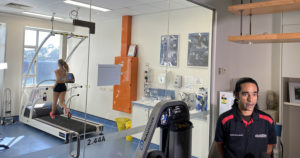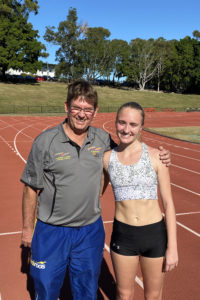Tokyo bound racewalker and Griffith University Occupational Therapy student Katie Hayward has turned the heat up onhertrainingregimeas the countdown tothe Gamesbegins.
She’scurrently completingtwice weekly sessions in a heated exercise labat Griffith’s Gold Coast campus, to acclimatise ahead of the warmer conditions expected in Tokyo, where she will compete in the 20km racewalk event.
“I feelthe fittest I ever been, and I am in such a great headspace”
“I’m really looking forward to heading to Japan very soon,” Katie said.
“I think after such a crazy year (2020) it’s amazing to be able to still travel overseas and represent my country at the highest level possible in my sport.”

Dr Surendran Sabapathy with Katie Hayward training behind him.
Dr Surendran Sabapathy, Discipline Lead, Exercise and Sport at Griffith’s School of Health Sciences and Social Work, said Katie’s heat training, combined with a stint in Cairns just before departing for Tokyo, would help her adjust to the expected temperature and humidity in Sapporo.
“When performing in hot and humid environments, endurance and team-sport athletes unaccustomed to such conditions typically experience decrements in performance,” he explained.
“A period of training in, or even passive exposure to, a hot and humid environment results in adaptive changes that can preserve or even enhance performance.”
“Typically, 7-14 days of consecutive training in the heat or even passive heat exposure is thought to confer full heat acclimation, but this can vary between individuals.
“Adaptive changes, includingincreases in blood volume, enhanced sweat responses and heat dissipation, and improved thermal tolerance, lead to improved athletic performance and thermal comfort in the heat. These adaptations also lead to better body temperature regulation that may reduce the risk of heat-related injuries.”

Racewalker Katie Hayward with long-time coach Steve Langley on Griffith’s athletics track at Gold Coast campus.
Long-time coach Steve Langley, who first spotted Katie’s potential at a Little Athletics meeton the Gold Coastmore than 10 years ago,saidall aspects of her training and development were going exceptionally well.
“In all facets she’s definitely developed some strength, physicallymentallyand emotionally.This last 12 months with the Olympics being postponedthere has been a dramatic change in Katie,” Steve said.
“Being younger makes it tougher as its certainly a gruelling event and you have to beemotionallystrong, not just physically, but Katie shows great maturityand she’s already been part of that world stage.”
“I’ve learned to be such a stronger athlete and have grown in so many different aspects of my life as well,” Katie said.
“The times that we’re in at the moment, it’s a bit scary and uncertain,butI feel fine. I feel like Australia’s got it sorted and for us to be safe as possible.
“I’mcontinuing todo plenty of hardtraining sessions, keeping my diet right, checking in with peopleatmy gym,withmy psychologist, my dietician and just ticking all the boxes to get me on that plane.”
As asecond year Occupational Therapy student andmember of Griffith Sports College, Katie said their assistance had been invaluable in her Games preparations.
“I’m very grateful to be part of the sports college, trying to juggle study and training,they’ve been such an amazing help for me to do both.
“Although young, I’ve learnt how to manage my own time very well (and) uni gives me an outlook where I’m not always thinking about my training. It gives me a little time to breathe and focus something else that I’m also extremely passionate about in my life.”
Katie Hayward is one of more than 30 Griffith student athletes and 6 alumni bound for the Games, which start on 23 July.


